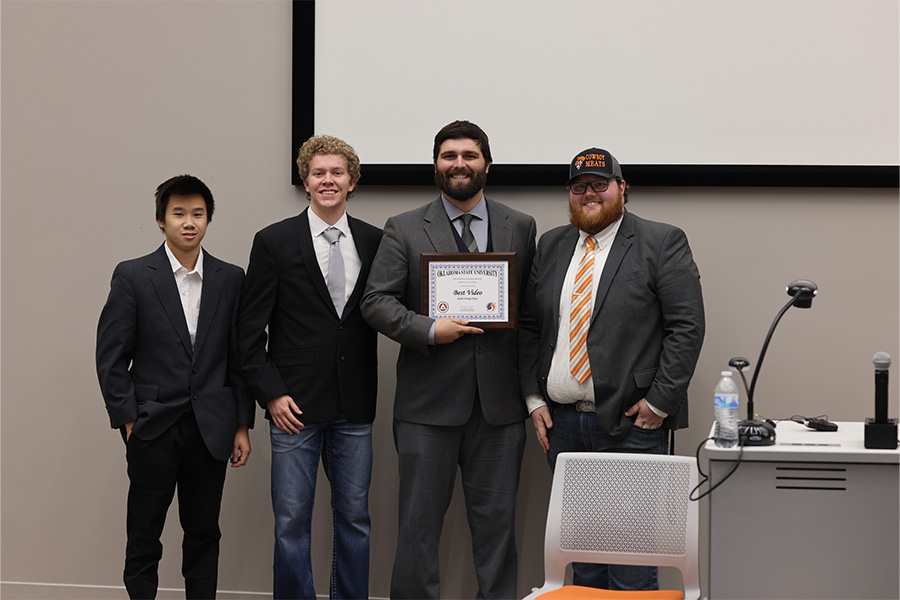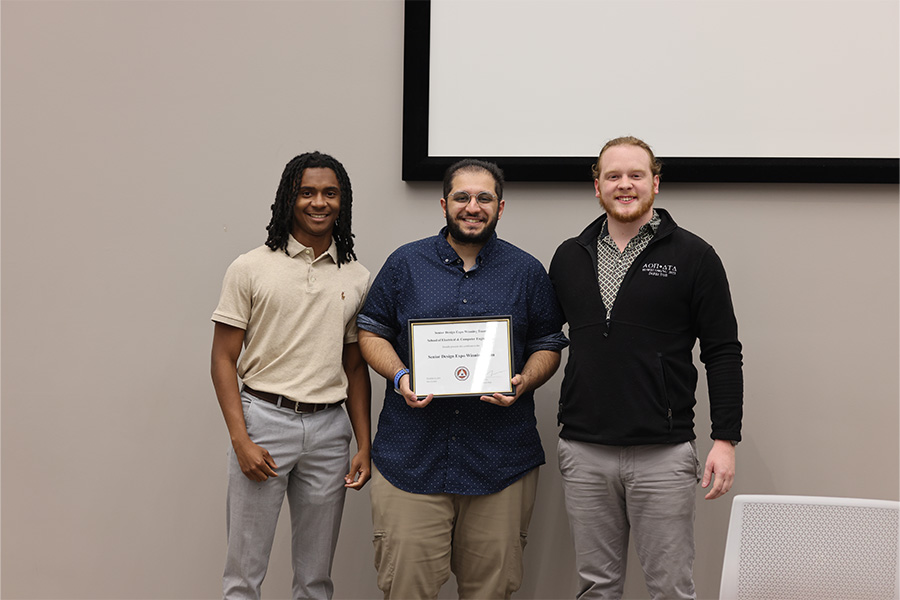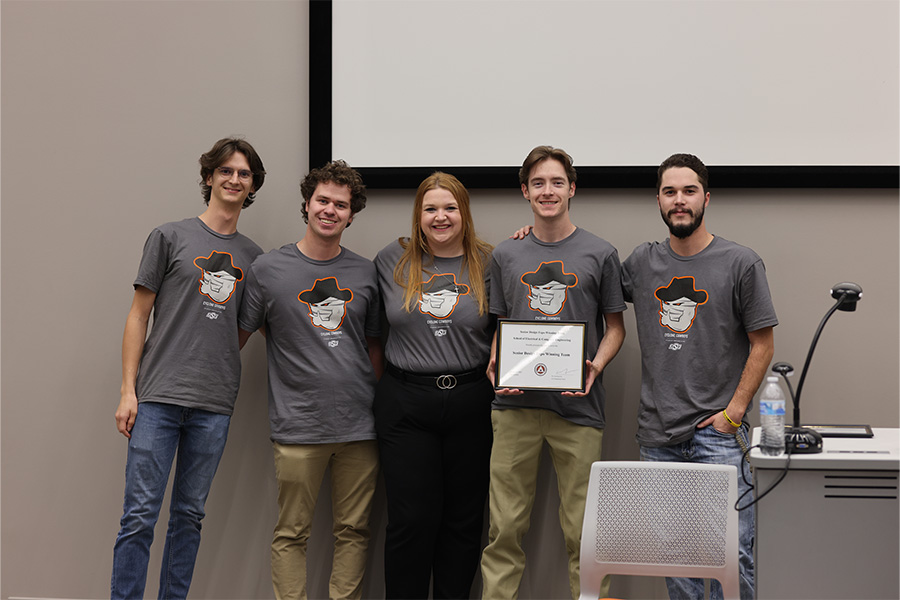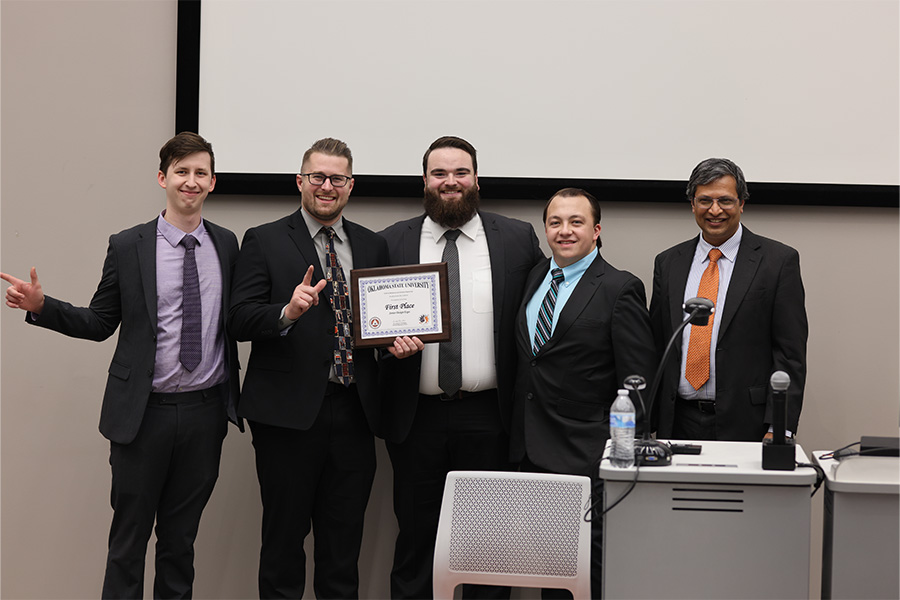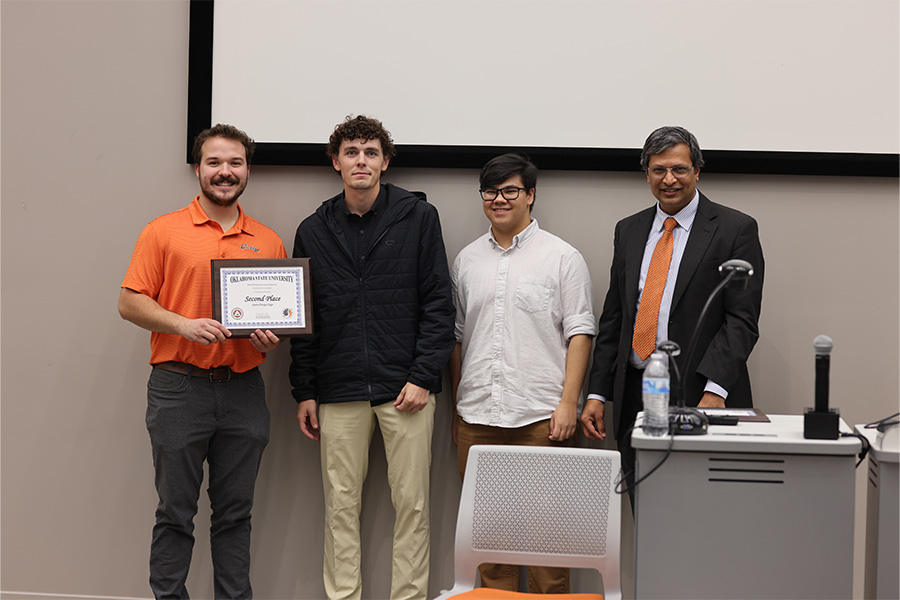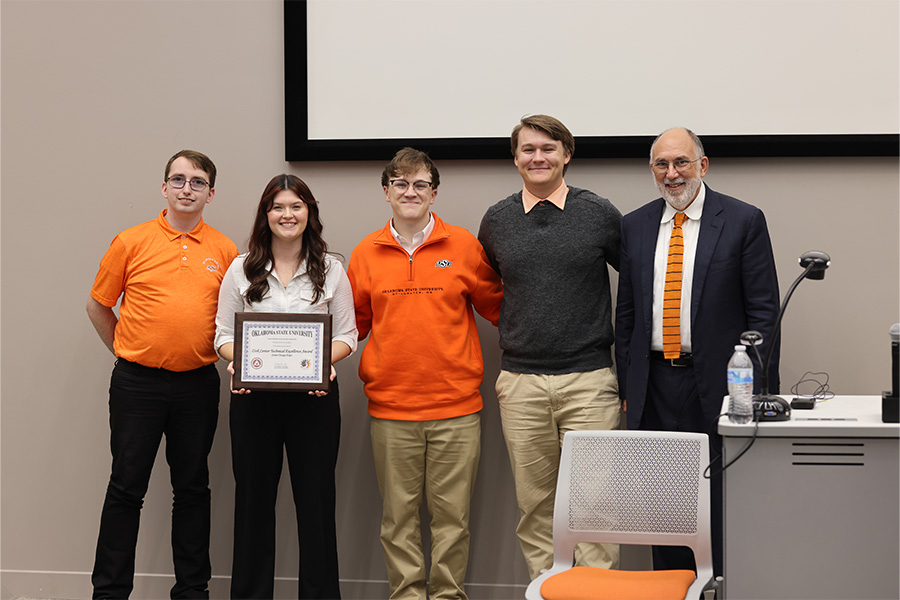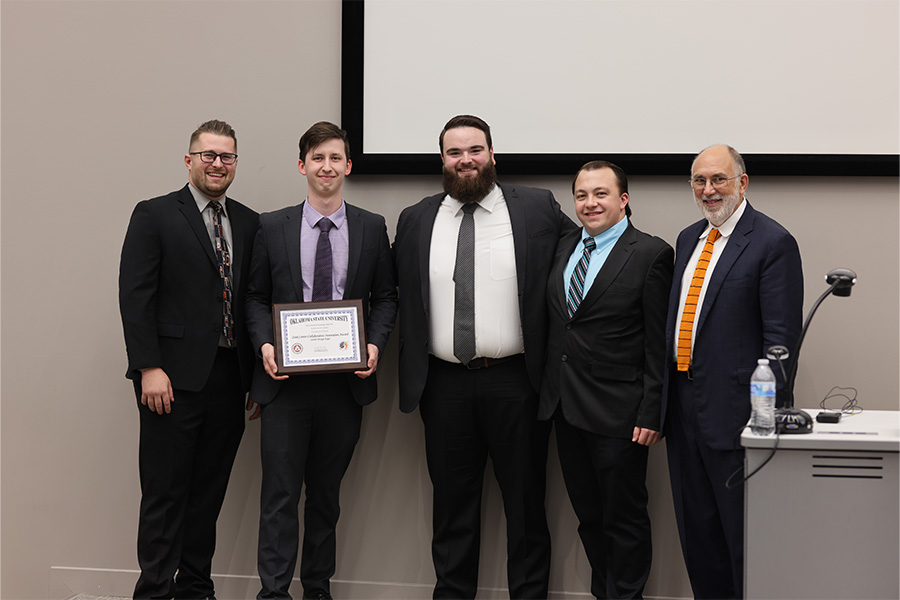
Fall 2024 Senior Design Expo shows off CEAT students' innovation
Monday, November 25, 2024
Media Contact: Tanner Holubar | Communications Specialist | 405-744-2065 | tanner.holubar@okstate.edu
The brilliance and innovation of College of Engineering, Architecture and Technology students was on full display Friday during the 2024 fall Senior Design Expo.
The expo is an opportunity for CEAT students to present their research projects to their peers and have the chance to show off the hard work and dedication they have put into Senior Design projects.
There were 199 degrees bestowed to CEAT students who now head off on their paths toward making a difference in the world.
Trash collector to help cleanup ahead of 2028 Olympic Games
One Senior Design team worked on a project that could help clean the Oklahoma River ahead of the 2028 Olympics known as the Cowboy Collector.
The team consisting of Austin Brown, Jace Brownlee, Reece Hicks, Nicolas Jolin and Antonio Valencia had a goal of developing an autonomous boat designed to clean floating trash in the Oklahoma River in Oklahoma City.
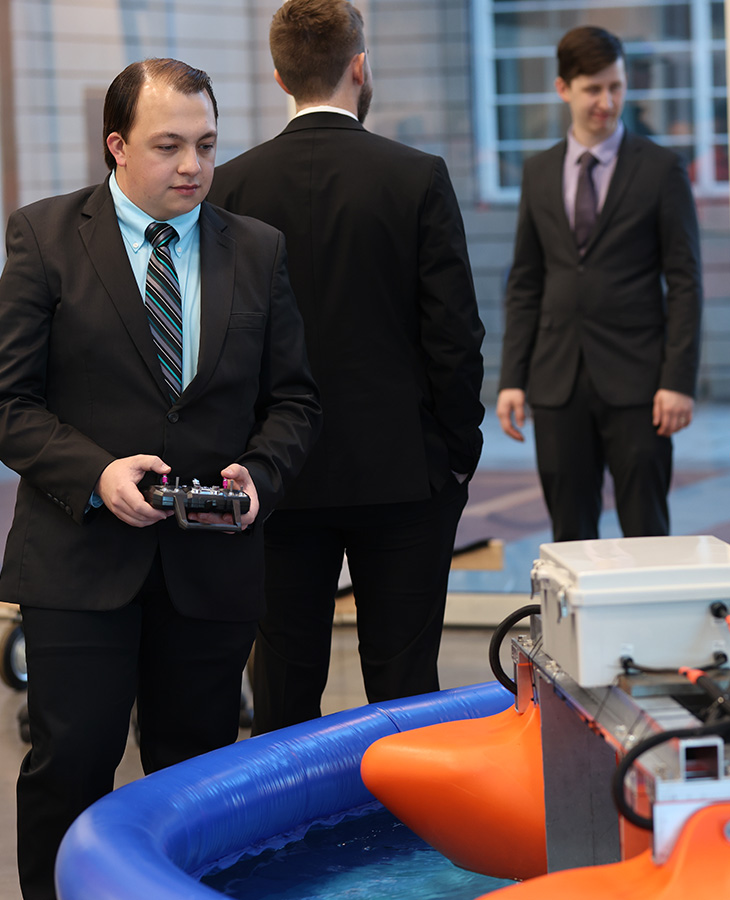
The boat would be capable of navigating the river, safely and efficiently removing floating debris and disposing of it autonomously. The team’s primary focus was to establish the foundational framework and logistics to be continued by future Senior Design teams to be completed in time for the Olympics.
The team developed the boat's dimensions, calculated its trash collection limit and designed the electronics system. Valencia said one of the biggest challenges the team faced was a custom conveyor belt system.
“Standard conveyor belt designs did not meet the project's unique demands, requiring significant customization rather than an off-the-shelf solution,” Valencia said. “While the ultimate goal is full autonomy, we opted to aim for a radio-controlled prototype by the end of the semester. This decision not only ensured the inclusion of manual control capabilities, an essential feature regardless, but also allowed us to avoid rushing through the project and compromising its quality.”
With this project being a new and major initiative, the team needed to have predetermined specifications or data to guide them. It made the project like a real-world scenario for a project undertaken by an engineering firm.
“Beyond designing and building the trash collection robot, we conducted extensive research, visited the Oklahoma River to assess the operating area, and interviewed city officials and representatives from the Riversport district,” Valencia said. “These efforts allowed us to generate the critical specifications and parameters necessary to design a functional and effective system.”
The Cowboy Collector will be able to efficiently remove small trash debris, such as Styrofoam cups, bottles and aluminum cans.
The team is proud of its efforts in laying the groundwork for future Senior Design teams to continue their work. Valencia said contributing to a sustainable initiative has been a rewarding experience.
“It's a reminder of how engineering is as much about solving real-world problems as it is about teamwork and adaptability,” Valencia said. “I'm excited to see how the project progresses in the coming years and the lasting impact it will have.”
Off the grid with zero energy Tiny House
The Tiny House project was initially brought to CEAT students in previous semesters by Dr. Jeffrey Spitler and graduate students Gabriel Parker and Pouria Moghimi-Ghadikolaei.
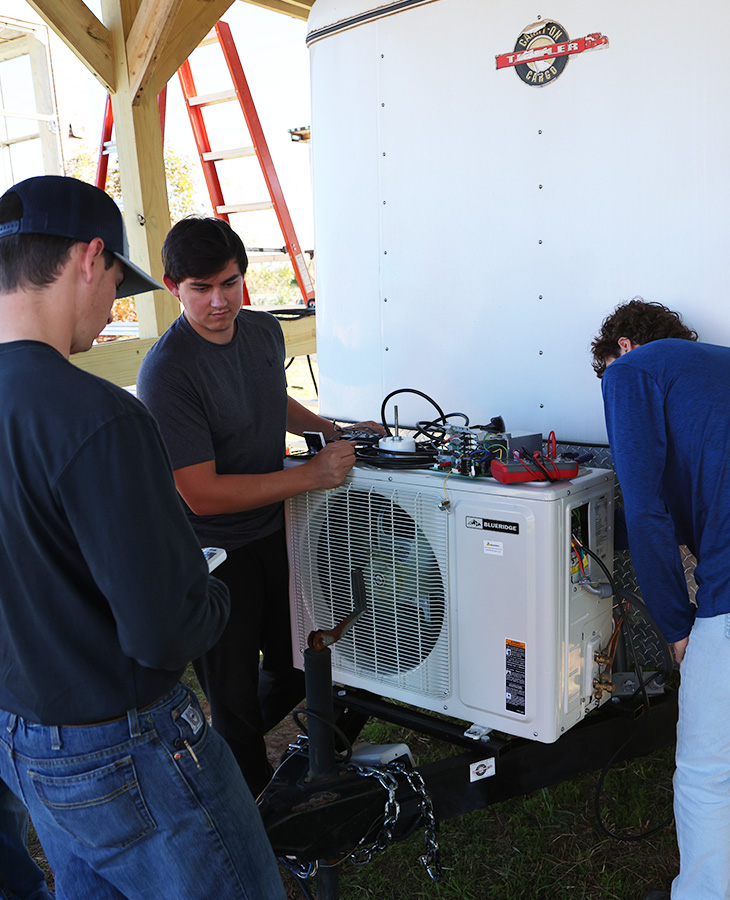
Students have worked on this project on a semester-by-semester basis to create a concept for a tiny home that can heat and cool itself using a solar-powered system and a thermal energy storage tank.
The team has had members working on the heating, ventilation and air conditioning system, solar panel system and the controls for the Tiny House. It is set up with two trailers side-by-side and connected by wiring. The trailers sit under a carport that has a solar panel system on top of it. One of the trailers would be where someone lives, and the other would contain the HVAC system.
The team consisted of Ahmad Alshemeri, Ralqattan Alqattan, Eduardo Benitez-Mejia, Brian Douglas, Adam Mason, Josh Marshall, Garon Kourt, Chase Skokos, Dmitry Vodnev, Daniel Windle and Sam Shuster.
Shuster, a member of the solar panel team, said this is one of the longest-running Senior Design projects, and this is the fourth or fifth semester it has been featured.
“What we received at the start of the semester was a small-scale version of the completed HVAC system that was basically on a cart that would be wheeled around but was fully functional,” Shuster said. “We’ve essentially been upscaling that to actually put it inside of the two trailers and then it will be powered by solar panels.”
The controls team worked on electrical engineering to ensure the systems all function together and are controllable by an occupant.
The HVAC team has worked on upscaling the system to be able to power the Tiny House project.
Another team of students worked on ensuring the solar panels were installed and functional so they could provide power to the trailers.
Shuster said the innovative aspect of this year’s project is using a thermal storage tank, which will be buried near the home. He said they aren’t commonly used for HVAC purposes in residential buildings.
“It’s definitely been a lot of work,” Shuster said. “One day recently, we were here for 11 hours the entire day working on it. The teams have worked extremely hard, so I’m really proud of them for getting this far. When we laid out expectations at the start of the semester, I thought they seemed like lofty goals for 11 guys to get done. But we’ve been out here pretty much every day for the past two months getting things done.”
Bio-inspired pneumatic hand
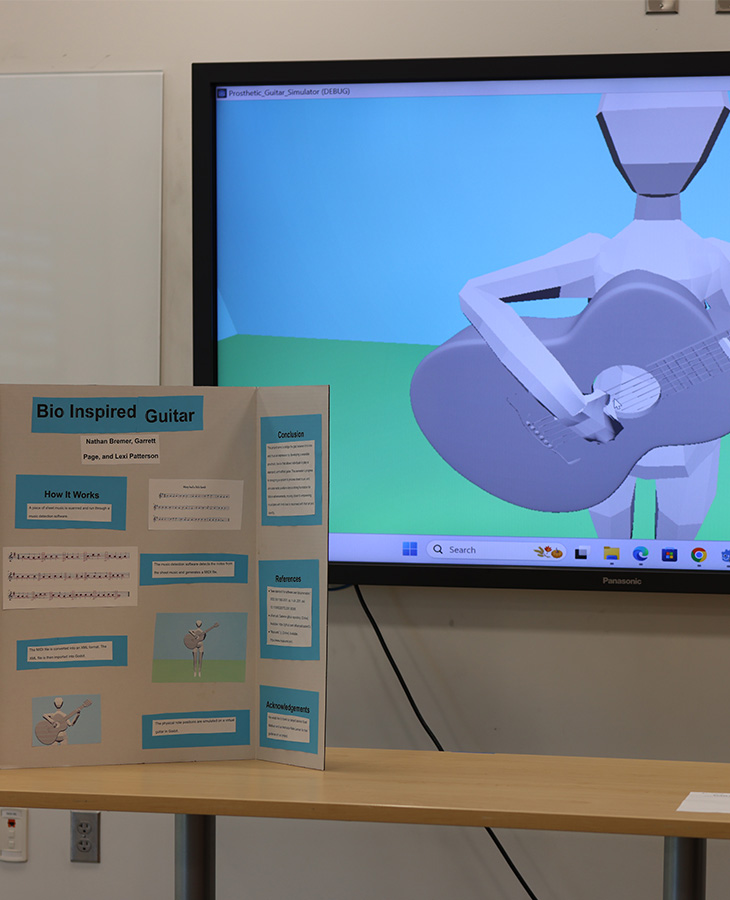
The team of Nathan Bremer, Garrett Page and Lexi Patterson worked on a project that was first part of Senior Design in the spring 2024 semester to create a bio-inspired pneumatic hand to enable users to have the capability of complex finger movement to play the guitar, as well as other possibilities.
It would be a device capable of intricate hand movements and could have precise movement, flexibility and responsiveness. This semester, the team worked on software development in Godot, an open-source game engine that will be used to train a physical pneumatic hand in the future.
The team is also working on implementing machine learning into the project to detect sheet music, creating a Music Instrument Digital Interface file. This would allow the hand to help a person play a musical score.
“The final design of the hand will need to be very dexterous, like a human hand,” Bremer said. “The 3D model that we have been working on has focused on modeling the human hand as best as reasonably possible in the time frame that we have.”
Bremer said the hand would have the dexterity to help with tasks that require fine control but great agility.
“The hope is to make a hand that can function similarly to a regular human hand,” Bremer said. “For those that have lost a limb, this would give them back a hand.”
Autonomous Firefighting Vehicle
The team of Ben Sailor, Mohammed Shestar and Millyan Stinson expanded on a project that began in fall 2022 to develop an autonomous firefighting vehicle.
The goal is to develop a vehicle that can autonomously navigate an area engulfed in flames, locate and extinguish the fire.

The team has worked to develop the self-driving capability of the vehicle, which uses a combination of Google Maps' Applied Programming Interface and the A-Star algorithm to find the shortest path along a roadway between its starting point and end point, where the fire is located. The coordinates are then transmitted from the ground station to the vehicle.
Sailor said the team rewired the vehicle to accept different batteries, cleaned the hardware and wiring, re-calibrated the motors, programmed a wrapper class for the IMU and a wrapper class and communication protocol for RF modules and implemented all these efforts together.
“This final product will hopefully be a fully self-driving vehicle that can get itself from the start location to the end location in an efficient and timely manner,” Sailor said.
The vehicle has a thermal camera to detect fires and lidar sensors to determine distance. It uses a machine-learning algorithm to determine the fire’s orientation, and it can then position itself a safe distance from the fire, exposing it to less heat.
They have focused on the autonomous movement of the vehicle.
“The process of working on this project has gone very well for the team,” Sailor said. “None of us have classes on Tuesdays or Thursdays, so we have spent most of those days every week working on it. Our group has worked very well together; we each have different strengths that have complemented each other well. We have all become good friends throughout the project, and working on it has felt like less of a class and more like a fun hobby.”
CEAT holds a Senior Design each fall and spring semester, with students continuing work from previous project teams. Altogether, 155 students took part in fall 2024.
After the Expo, awards were given to honor the students' great work on their projects.
The Best Video award went to Bullet's Tow - Safety Tow. The ECE only winner was the team that worked on the Autonomous Firefighting Vehicle. The ECE Interdisciplinary Award went to the Cyclone Cowboys team. The MAE first place award went to the Cowboy Collector - Autonomous Trash Collection Boat. The MAE second place award was given to the FlexRig - Knee Testing Rig team. The DET winning team was Bullet's Tow - Safety Tow.
Two awards were given out, each of which came with $2,500 cash prizes to be split between team members. The Zink Center Technical Excellence Award went to Sats Are For the Cube - OKCubeSat. The Zink Center Collaborative Innovation Award went to the Cowboy Collector team.
Senior Design Fall 2024Award winners
